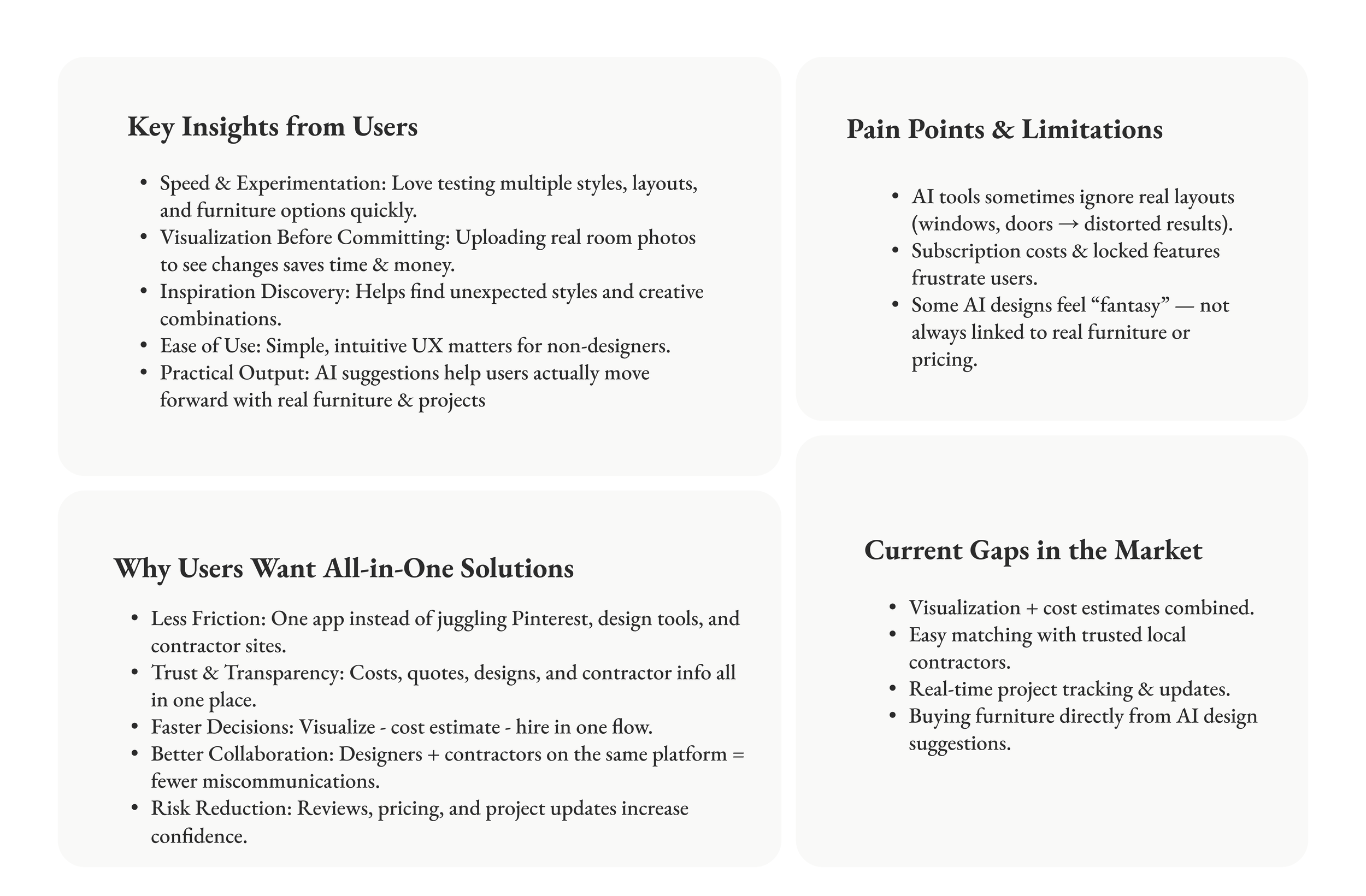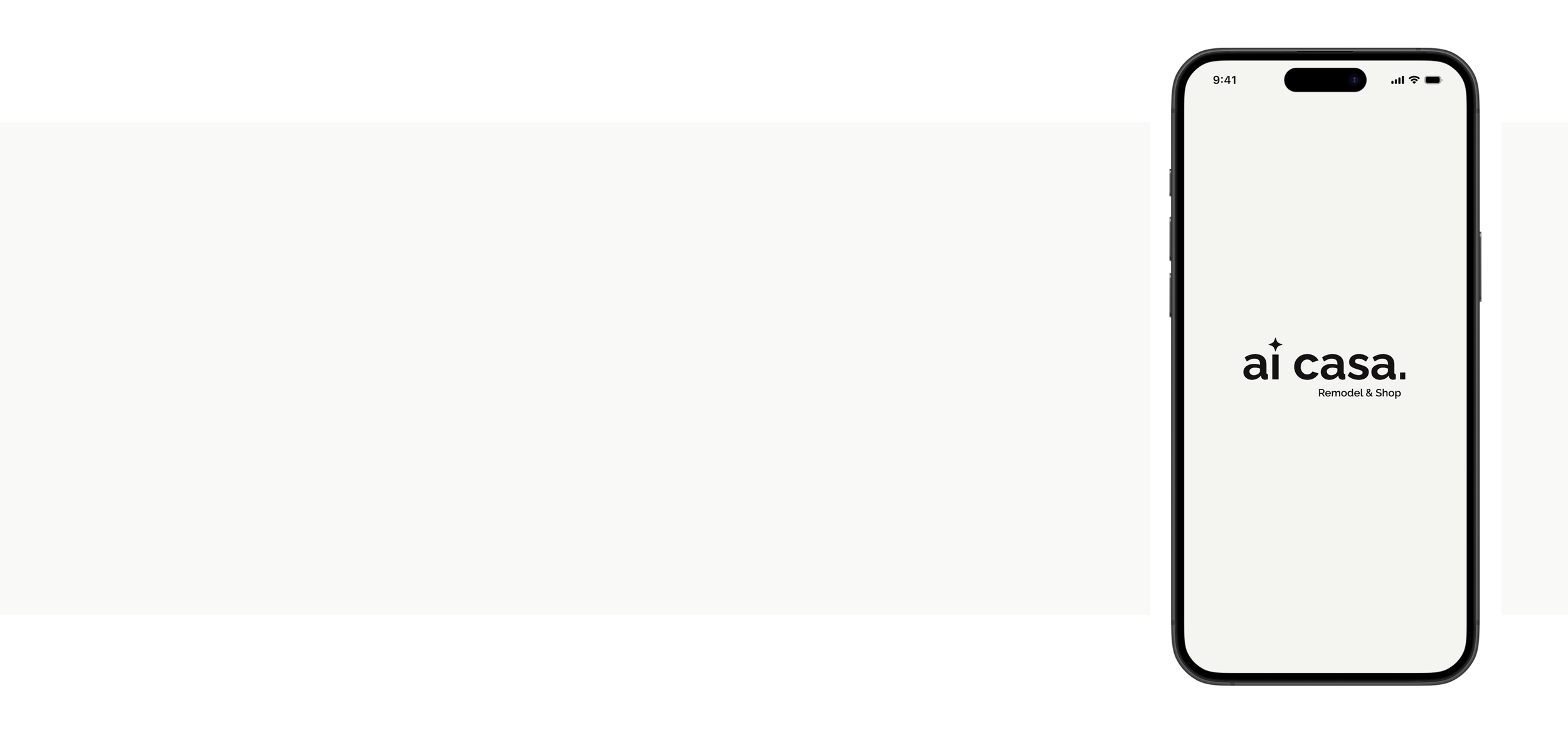Ai Casa
Challenge: Develop an AI-powered home renovation app to help users design creatively and connect with professionals
Deliverables: Competitive analysis. User surveys and interviews. Testing Report. Personas. Task flows.
UI Library. Prototype. Usability tests.
Role: UX Researcher. UX Designer. UI Designer. Branding. Storyteller. Interior Designer.
Coming Soon!
Coming Soon!

Challenge
Remodeling a home can be overwhelming. Homeowners struggle to visualize changes, source the right furniture, and connect with reliable professionals.
On the other side, interior designers spend hours creating mood boards and 3D concepts to present to clients, often without a single tool that combines inspiration, AI-powered rendering, and local contractor connections in one place.
The Solution
For Homeowners:
One app → from idea to final design → to hiring professionals → to shopping furniture. Saves time, reduces stress, and gives a clear vision before investing money.
For Designers & Contractors:
Less time spent on quick ideas → more leads → better client communication. A single platform for design, client management, and project discovery.
Impact
Efficiency - Instantly remodel, preview, and iterate without long delays.
Confidence - Make decisions backed by AI insights and trusted local professionals.
Creativity - Unlock endless design possibilities, tailored to your style.

Quick Links
As an interior designer with over a decade of experience, I’ve witnessed how quickly design expectations have changed — and how clients now expect instant, realistic results.
Homeowners want to see transformations before committing. Designers, on the other hand, struggle to balance creativity with speed and technical demands.
That gap inspired me to create an AI-powered remodeling app — a tool that simplifies decision-making and helps both sides visualize, design, and connect more confidently.
This concept focuses on efficiency, confidence, and creativity, bringing professional-level visualization tools into everyone’s hands.

I created an AI-powered remodeling platform that helps anyone reimagine their living spaces with professional-level tools.
Users can:
Instantly redesign interiors and exteriors
Turn hand sketches into 3D models
Erase and replace furniture, experiment with finishes, and preview results in AR.
Beyond visualization, the app connects design with action:
Users can shop recommended furniture, Build wishlists, and connect directly with local professionals. An AI copilot offers style tips and product suggestions , while personalization ensures results adapt to each user’s unique preferences.
For homeowners, this means visualizing remodels in seconds, discovering personalized furniture suggestions, and connecting instantly with professionals who can bring those ideas to life. For designers, it’s not just a tool for inspiration—it’s also a discovery channel, helping them showcase their work and find new projects without extra marketing efforts..
Designer–Developer Sync: AI Implementation Insights
I wanted to understand how the AI functions and how it will contribute to the quality of my application.
That’s why I sat down with the tech developer (AI Engineer) to discuss the implementation process and potential challenges of building an AI-supported app.
From our long conversation, I’ve highlighted a few key questions and answers:
LS: “How does the model handle input quality—are low-light or cluttered photos likely to reduce accuracy?”
AI Engineer: “The model can process imperfect photos, but clutter and poor lighting often reduce accuracy in object detection and rendering. Users might see less precise results if the input is messy..”
Research
I conducted extensive research to understand how people currently plan, visualize, and execute remodeling projects.
The following slides (available when you click the button below) include secondary research, competitive analysis, user interviews, personas, empathy maps, and journey maps — all guiding the core experience of this app.
Right now, 91% of homeowners haven’t used AI for renovations yet—only 9% have tried it, and mostly younger people like Millennials (16%) are leading the way.
When they do use AI, it’s mostly for design ideas (73%), cost estimates (52%), and virtual mockups (43%).
Designers, on the other hand, are far ahead —85% are already using AI, especially for 3D visualization and rendering.
Around 55% of homeowners have used some kind of virtual tool for planning, and 42% say they’re open to AI assistants for remodeling help.
The renovation market is growing steadily, with large dollar volumes and people increasingly investing in improving existing homes rather than buying new.
Digital tools are becoming more common, and some homeowners are open to using AI (especially younger demographics).
Finding contractors is often via referrals, reviews, online searching, rather than centralized
platforms in many cases.Many people use virtual visualization tools, but the adoption of more advanced AI tools is still relatively low — so there's room for growth and an opportunity for all-in-one app.
So no, AI apps hasn’t replaced Pinterest yet—most people still start there for inspiration—but awareness is growing fast.
And the gap between what homeowners have today and what they want in the future?
That’s where my app comes in.
Research Foundations
To support the design and feature decisions behind this app, I conducted a series of research activities focused on understanding market trends, user needs, and professional workflows.
Each document below expands on the discovery phase and provides context for how insights translated into product strategy.
Competitive Analysis
I began by comparing leading AI-powered interior design and remodeling tools in the market, analyzing their core features, visual presentation, and user experience patterns.
This analysis includes 10 direct competitors, each offering distinct approaches to interior visualization—from simple mockups to full 3D rendering platforms.
It also reflects a broader shift in the industry: the rise of AI-driven tools that can turn a single prompt or photo into a fully staged, realistic interior. This growing trend underscores the demand for speed, simplicity, and creative empowerment—values that shaped the foundation of this app.
View Competitive Analysis
User & Professional Interviews
To better understand the needs of both homeowners and design professionals, I created two tailored interview guides:
One for homeowners/users and One for designers, architects, and contractors.
Across 10 questions per group, responses revealed:
Different levels of comfort with AI tools across age groups (millennials showed strongest adoption), High interest in using AI for visual experimentation and confidence-building & Shared appreciation for a platform that connects users with verified professionals to bring their ideas to life.
View Q&A
View Personas, Empathy & Journey Maps
From research insights, I developed two detailed personas—Emma (Homeowner) and David (Interior Designer)—to represent core user segments.
These personas evolved into Empathy Maps that visualize how each user thinks, feels, acts, and reacts throughout the design process.
Each map is structured into four quadrants: Think & Feel, See, Say & Do, Pain & Gain.
This helped identify emotional drivers, unmet needs, and opportunities for product differentiation.
View Personas, Empathy & Journey Maps
Understanding Users
UI Kit & Logo
A consistent visual language was built to ensure the app feels modern, intuitive, and cohesive.
The UI Kit defines the color system, typography, icons, and components used throughout the design.
For the purposes of this case study I designed a logo that serves as a conceptual example—highlighting features and design directions beyond what was included in the original implementation.
Ui Ki
Splash Screen
The splash screen delivers a vibrant first impression—setting the tone for a seamless, inspiring remodeling experience from the very first tap. It reflects the app’s vision: clean, minimal, intuitive design, smart features, and a personalized journey toward transforming any space.
The Onboarding
For the purposes of this case study, I designed a logo that serves as a conceptual example—highlighting features and design directions beyond what was included in the original implementation.
Quizz
I designed the quiz before sign-up to create immediate value for users. Instead of asking them to commit upfront, the quiz lets them quickly explore their personal style and see what the app can do for them.
This approach:
Reduces drop-off rates because users engage first before facing a sign-up wall.
Creates a personalized experience right from the start—results feel unique to them.
Acts as a value teaser: users see their style profile and AI suggestions, making them more likely to sign up to unlock the full experience.
It turns onboarding into a fun, interactive moment rather than just a form to fill out.
Design Intent:
The quiz-first approach makes onboarding personal and engaging, while the login screen ensures data persistence and a smooth transition into a customized experience.
Signup Screen appears with two options:
1. Create an Account: Enter name, email, and password to start.
2. Continue with: Google, Facebook, Apple (optional, based on platform).
Once logged in, the user’s quiz data (preferred styles, materials, mood) automatically syncs to their profile. The user is redirected to the Homepage — where all features (Remodel, AI Copilot, Shop, etc.) become accessible.
Homepage
The Homepage serves as the central hub where users can explore all app features — from AI remodeling tools and style exploration to shopping, saved projects, and connecting with local professionals — all in one intuitive, personalized dashboard..
The Renovate feature lets users redesign any room by choosing their preferred style and layout.
With AI-powered tools, they can create realistic images of their renovated space to visualize changes before making any commitments. Users can save their designs for future edits or inspiration, and once satisfied, they can shop the suggested furniture directly—the app will guide them to the retailer’s website for easy purchase. This makes planning and executing home renovations faster, simpler, and stress-free.
Explore Features: Interior Design Remodel + Reference Style Flow

Quick Link
Upload or Take a Photo & Select Room & Style
Choose which room you want to redesign and pick a style.
Upload Reference Style Photo & Prompt
Write a short prompt for AI enhancements or upload a reference style photo for inspiration.
Choose Colors, Ai Remodeling Intervention, Loading
Select your preferred color palette to personalize the look and feel.
Decide what the AI should change—walls, floors, furniture, or a full redesign.
The app generates the new design, visualizing all your selections in real-time.
I’ve been conducting usability tests with both consumers (homeowners) and professionals (designers, contractors, architects) as the app evolves. Testing focuses on core flows, new features, and UI clarity — while closely collaborating with the dev team to align feasibility with user experience.
Key Findings So Far:
Smooth Experiences
Flows such as Remodel Interior/Exterior, Reskin Furniture, Change Floors & Walls tested well.
Users described the experience as “easy,” “fun,” and “intuitive.”
Minimal intervention needed — these features will be further optimized but are already functional.
Smooth ExperiencesFlows such as Remodel Interior/Exterior, Reskin Furniture, Change Floors & Walls tested well.
Users described the experience as “easy,” “fun,” and “intuitive.”
Minimal intervention needed — these features will be further optimized but are already functional.
AR “Place in Space” Needs Guidance
Users followed the flow but weren’t always sure what to do next.
Feedback: Feature is “smart & useful” but needs on-screen tips or step-by-step guidance to make it feel seamless.
Connect with Pros
The questionnaire flow was a big hit.
Users appreciated how quick and personal it felt.
What We’re Improving Next
AR Onboarding Tips → Adding mini tooltips and progress markers to make “Place in Space” crystal clear.
Iconography & UI Clarity → Some icons were unclear — exploring simpler, more universal symbols.
Micro-interactions → Subtle animations to guide users visually through key steps.
Professional Dashboard (In Progress) → Contractors & designers will soon have their own board for profile creation, lead management, and project collaboration.
I should do this every day… if breaking the app counts as progress
Testing Daily: With different user groups to gather fresh insights and spot trends early!
Collaboration with Devs: Designers + Developers work closely; technical feasibility is shaping smarter UX decisions.
Iterative Design: Some features may evolve, expand, or be replaced based on user demand & emerging market needs.
























